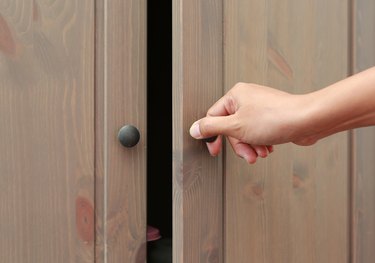
Door jamb frames consist of two vertical legs, or side jambs, and a horizontal board at the top, called the head jamb. When the door is attached with hinges to the completed jamb frame, the entire assembly is referred to as a prehung door. This all-in-one unit is often used in new construction to avoid separate installation of the jamb and the door. The same is true when you're building a custom jamb to fit a door opening. You can build a jamb frame and have the door installed in less than one afternoon.
Rough Opening Measurements
Video of the Day
The rough opening for the door must include space for the completed jamb and clearance for the door. Common door heights are 80 inches tall with widths running 28, 30, 32, 34 and 36 inches. A basic rule of thumb is to make the rough opening 2 inches wider and 2 1/2 inches taller than the door. This leaves room for the prehung door unit, space for shims to plumb and straighten the jambs, and clearance below the door for carpeting or other flooring material.
Video of the Day
Jamb Materials
Most jambs are made from 3/4-inch-thick pine, hemlock or fir. These softwoods are economical and easy to work with. You can also use oak or any other hardwood for a stain-grade jamb, but hardwoods are pricey and harder to work with, especially when preparing the jamb for hinges. Home stores and lumberyards also offer premade jamb material in widths to fit standard walls.
Jamb Measurements
When building a door jamb to fit a standard wall with a two-by-four frame and 1/2-inch drywall on each side, the width of the jamb board typically is 4 9/16 inches. If you're not using premade jamb material, or if your walls are a nonstandard thickness, you can buy 5- or 6-inch-wide lumber and rip-cut it to the width of the wall using a table saw. Premade jamb material comes sanded. If you cut it to width, you'll need to smooth and round the corners and edges with sandpaper.
The best tool for cutting jambs to length is a miter saw, but you can also use a circular saw or handsaw. If your rough opening measures 82 1/2 inches tall, cut the side jambs to length at about 81 inches, depending on how much clearance you want below the door. Cut the head jamb to length so it equals the door width plus the thickness of both side jambs plus about 1/8 inch for door clearance between the side jambs. The head jamb goes over the ends of the side jambs.
Install the Hinges
Install the hinges on the door if they are not already in place. Position one hinge 5 inches from the top of the door, one hinge 5 inches from the bottom of the door and the third hinge equidistant between the other two. If you have a lightweight interior door, you may need only two hinges with one at the top and one at the bottom.
Set the side jamb where you plan to install the hinges, flush with the side of the door as if it were already installed. Use a pencil to trace the outline of the hinges onto the jamb. If you're handy with tools, use a router to cut the shallow recesses, called the hinge mortises, or chisel them out by hand with a sharp wood chisel.
After cutting the mortises, test-fit the hinges to the door and jamb to verify everything works properly, then install the hinge halves on the jamb and door, respectively. Do not mount the door to the jamb yet.
Assemble the Jambs
Place the head jamb over the top ends of the side jambs. Use two or three 1 1/2-inch screws to fasten the head jamb to each side jamb, depending on how wide the jamb material is. When complete, you should have a door frame without a bottom piece. Install the door inside the jamb frame by assembling the hinges.
Hang the Door Unit
Stand the prehung door and jamb inside the opening. Tap some thin wedges between the jamb and rough opening. Cedar works well for this purpose. Use a variety of thicknesses, doubling them up if you need to. Use a level with the wedges to plumb the hinge-side jamb, tapping the wedges into the shim spaces as needed. Fasten the hinge-side jamb with 8d finish nails driven into the rough opening framing.
Close the door and check the gap between the door and the head and latch-side jambs; this space is called the reveal. Use shims to adjust the head and latch jambs so the reveal is consistent along the top and side edges of the door, then nail the head and latch jambs in place. Drive all nails slightly below the surface of the jambs with a hammer and nail set. Cut or break off any protruding wedges that extend beyond the door jamb.
Add the Door Stops and Hardware
Door stop molding goes around the inside of the jamb and creates a lip for the door to rest against when closed. The molding is typically 1 1/4-inches wide and 3/8-inch thick. It often has a flat edge on one side and tapers to a rounded edge on the other. The flat edge goes against the door.
Cut the stop molding with a miter saw, mitering the corners for a finished look, and nail it around the perimeter of the door with 4d finish nails. When the door shuts, the flat edge of the doorstop molding should be tight against the door. Leave a little room for weatherstripping if the door is an entry door or you want to weatherstrip for soundproofing. Use a nail set to drive the nails slightly below the surface of the wood. Fill all nail holes in the jambs and stops with stainable or paintable wood putty. Install the door handle latch hardware following the manufacturer's directions.